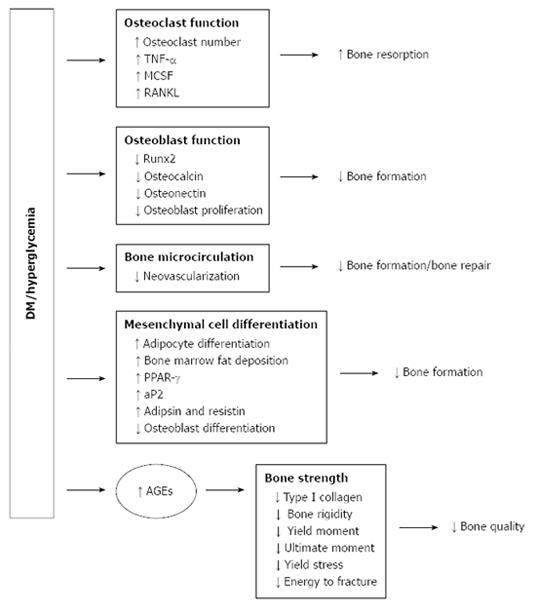Copyright
©2011 Baishideng Publishing Group Co.
World J Diabetes. Mar 15, 2011; 2(3): 41-48
Published online Mar 15, 2011. doi: 10.4239/wjd.v2.i3.41
Published online Mar 15, 2011. doi: 10.4239/wjd.v2.i3.41
Figure 1 Possible deleterious effects of diabetes mellitus on bone metabolism and bone quality.
Diabetes mellitus (DM) increases osteoclast function but decreases osteoblast function, thereby leading to accelerated bone loss, osteopenia and osteoporosis. DM/hyperglycemia induces production of macrophage colony stimulating factor (MCSF), tumor necrosis factor (TNF)-α and receptor activator of nuclear factor-κB ligand (RANKL), all of which are osteoblast-derived activators of osteoclast proliferation and differentiation. Moreover, DM/hyperglycemia suppresses osteoblast proliferation and function, in part, by decreasing runt-related transcription factor (Runx)-2, osteocalcin and osteopontin expressions. Adipogenic differentiation of mesenchymal stem cells is increased as indicated by the overexpression of adipocyte differentiation markers, including peroxisome proliferator-activated receptor (PPAR)-γ, adipocyte fatty acid binding protein (aP2), adipsin and resistin. A decrease in neovascularization may further aggravate bone loss. Bone quality is also reduced as a result of advanced glycation end products (AGE) production, which may eventually result in low-impact or fragility fractures.
- Citation: Wongdee K, Charoenphandhu N. Osteoporosis in diabetes mellitus: Possible cellular and molecular mechanisms. World J Diabetes 2011; 2(3): 41-48
- URL: https://www.wjgnet.com/1948-9358/full/v2/i3/41.htm
- DOI: https://dx.doi.org/10.4239/wjd.v2.i3.41









